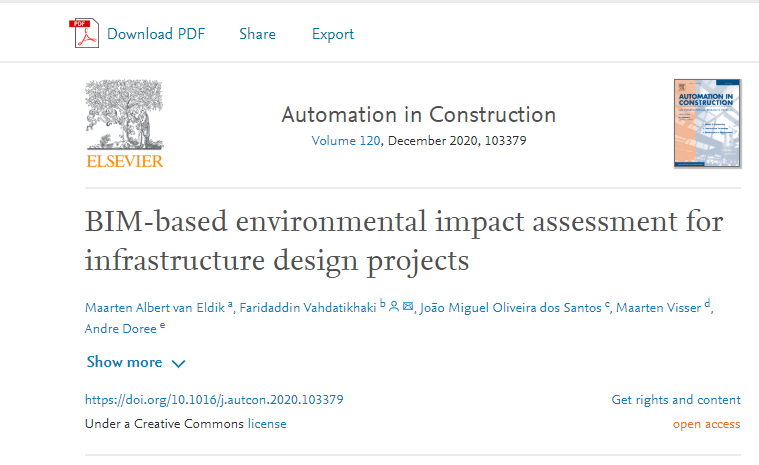
Pub Date : 2020-08-24
摘 要
Sustainability is becoming a key factor in the decision-making process of infrastructure projects throughout their lifecycles. In particular, the Environmental Impact Assessment (EIA) in the design phase is becoming a matter of significant importance, for both public and private sectors, given the long-term impacts of design decisions on the environmental performance of infrastructure projects. Traditionally, EIA is performed by a sustainability expert at the end of the design cycle, by which time the modification of design is both costly and time-consuming. In recent years, Building Information Modelling (BIM) is leveraged to better integrate EIA with the design practices. However, there are several limitations with how this integration is approached: (1) EIA is normally performed by software other than the one used for the design. This renders the continuous EIA based on incomplete BIM models difficult; (2) there is a lack of explicit data structure for the integration of EIA and BIM data. This limits the interoperability and flexibility of the EIA tools in terms of accommodating to different EIA databases; (3) in the majority of the cases the integration of EIA and BIM is not bidirectional, which results in the incapacity of the designers to immediately visualize the results of EIA in the design platform and to track the progress of the design in terms of EIA; and (4) the BIM-based EIA has rarely been implemented in an infrastructure project. Therefore, this research aims to develop a continuous BIM-based EIA for infrastructure projects that utilizes an explicit data structure to (1) systematically integrate data from various sources, and (2) enable bidirectional data exchange between BIM and EIA. The framework allows designers to run an automated EIA at any point in the design stage and immediately assess the Environmental Impact Score (EIS) of their design choices. A prototype is developed and tested on a case study to indicate the feasibility of the proposed framework. The framework is assessed in terms of functionality, ease of use, scalability, and contribution to raising sustainability consciousness through a workshop with experts. It is shown that the framework is able to quickly provide designers with accurate information about the potential environmental impact of all objects in infrastructure design projects. The workshop with experts showed that the tool clearly makes it easier to perform EIA compared to the existing, highly fragmented, process. This allows the design team to use this assessment on the same level as other design parameters in the decision-making process.
链接:
https://www.sciencedirect.com/science/article/pii/S0926580520309596
02
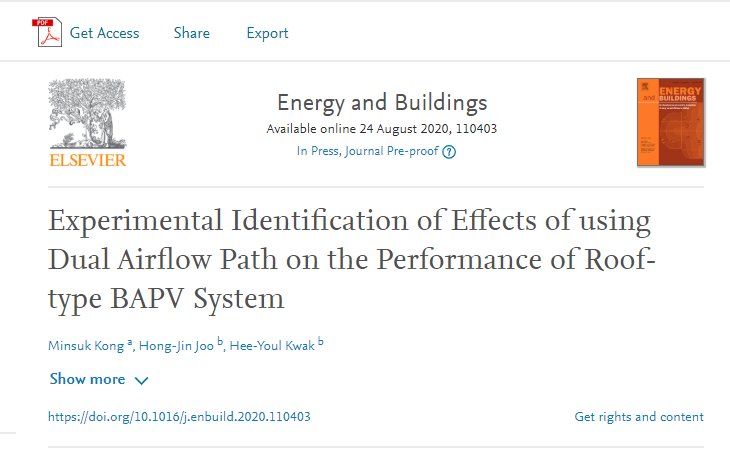
Pub Date : 2020-08-24
摘 要
Photovoltaic (PV) modules attached to the building exterior have a problem with efficiency reduction due to temperature increase of the modules. To minimize the temperature increase of the PV modules, this study proposes a passive cooling technology that can improve the natural cooling performance by creating dual airflow paths for the building applied photovoltaic (BAPV) system. To experimentally verify this natural cooling technology (NCT), a BAPV system with the NCT and a conventional BAPV system of the same capacity were constructed, and their power-generation performances based on the three-month experimental results in a cold weather season were compared under the same environmental conditions. The BAPV system with the NCT on average generated 4.5 % more power than the conventional BAPV system. The performance ratio (PR) analysis showed that the average PR value of the BAPV system with the NCT was 87.1 %, which was approximately 5.5 % higher than that of the conventional BAPV system. Results suggest that the proposed NCT improved the airflow on the backside of the PV modules and supplied fresh air to all of them, and hence, it improved the cooling performance and induced relatively lower module temperatures. A correlation between the electric power generated and the solar irradiance was derived for each system.
链接:
https://www.sciencedirect.com/science/article/abs/pii/S0378778820311701
03
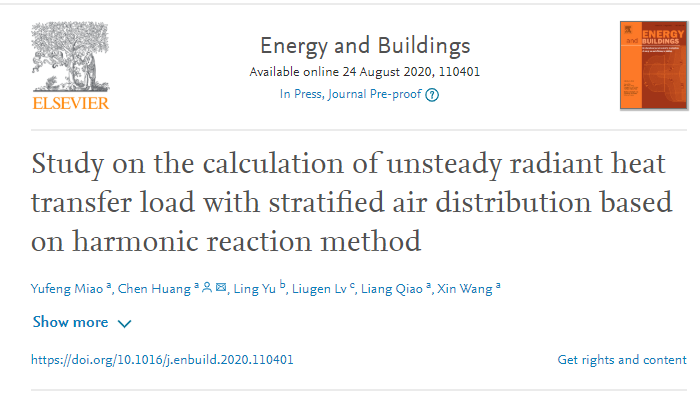
Energy Build. (IF 4.867)
Pub Date : 2020-08-24
摘 要
The stratified air conditioning systems are widely used in large space buildings. Stratified air conditioning load (SACL) is the basis for determining the cooling capacity of air conditioning system, and it is also the key to assess its energy savings of stratified cooling. Calculation of the radiant heat transfer load (RHTL) is the difficult point to determine the SACL. In recent years, there have been many researches on the calculation of SACL. Most of them are steady-state calculation processes, and there are few studies on dynamic calculation processes. Therefore, the RHTL is taken as the research object, a novel calculation method is proposed according to the harmonic reaction method (HRM) and verified by the experiments. Experimental radiant heat transfer load can be received through convection and radiation separating method. The experimental and theoretical values of RHTL were compared and it was found that the theoretical values were in good agreement with experimental values. Therefore, the proposed method can be used to predict the unsteady RHTL accurately. Based on the verified calculation method, the effects of outdoor climatic conditions, building types and stratified heights on RHTL of an actual large space building are analyzed, which will contribute to the design and optimization of stratified air conditioning system for large space buildings.
链接:
https://www.sciencedirect.com/science/article/abs/pii/S0378778820304205
04
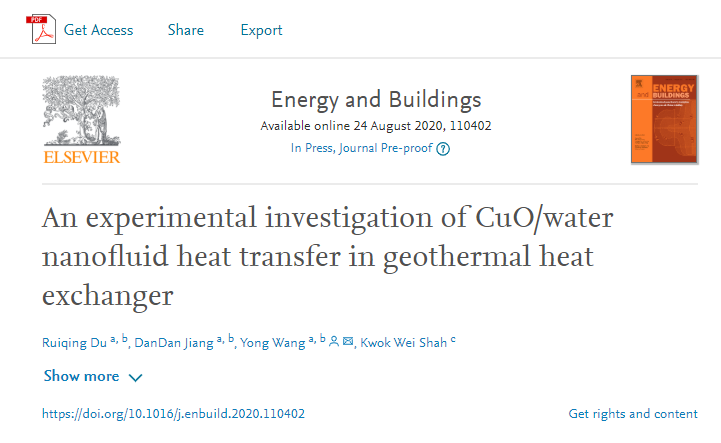
Energy Build. (IF 4.867)
Pub Date : 2020-08-24
摘 要
The energy efficiency of geothermal heat exchanger (GHE) systems can be significantly impacted by the thermal performance of heat transfer fluid inside. In the present study, nanofluid (CuO/water) was experimentally used in the GHE to investigate its thermal performance as circuit fluid. The main part of experimental system consisted of a 0.8 m × 0.5 m × 0.58 m box, two double U-tubes, thermocouples and thermal resistors. A three-dimensional discrete phase model was built to simulate the flow process. By using nanofluid, the heat transfer rate and pumping power consumption of the GHE system increased by 39.84% and 16.75%. Moreover, the heat load-to-pumping power ratio had an enhancement of 20.2%. Furthermore, the previous literature showed that the nanofluids, which had a significant effect on the heat transfer of other types of heat exchangers, had an insignificant effect (less than 5%) on the energy efficiency of GHEs. The simulation result showed that the special structure of traditional GHEs may be the main reason for the lower possibility of collision between nanoparticles and the insignificant effect of nanofluid on its heat transfer enhancement. Therefore, the length of every straight tube segment should be restricted to achieve the better thermal performance of GHEs using nanofluids as heat transfer fluid.
链接:
https://www.sciencedirect.com/science/article/abs/pii/S0378778820315978
05
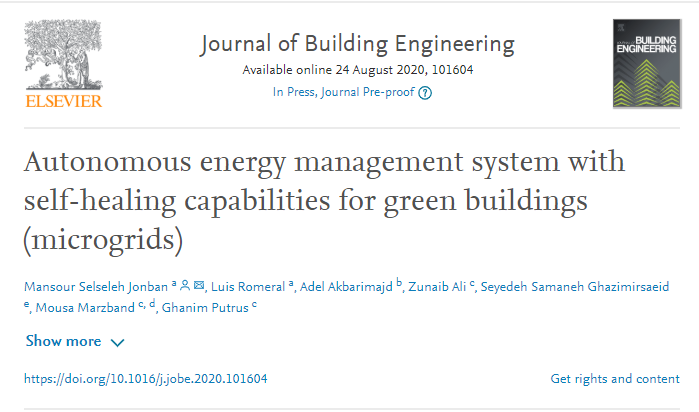
J. Build. Eng. (IF 3.379)
Pub Date : 2020-08-24
摘 要
Nowadays, distributed energy resources are widely used to supply demand in micro grids specially in green buildings. These resources are usually connected by using power electronic converters, which act as actuators, to the system and make it possible to inject desired active and reactive power, as determined by smart controllers. The overall performance of a converter in such system depends on the stability and robustness of the control techniques. This paper presents a smart control and energy management of a DC microgrid that split the demand among several generators. In this research, an energy management system ( EMS) based on multi-agent system ( MAS) controllers is developed to manage energy, control the voltage and create balance between supply and demand in the system with the aim of supporting the reliability characteristic. In the proposed approach, a reconfigurated hierarchical algorithm is implemented to control interaction of agents, where a CAN bus is used to provide communication among them. This framework has ability to control system, even if a failure appears into decision unit. Theoretical analysis and simulation results for a practical model demonstrate that the proposed technique provides a robust and stable control of a microgrid.
链接:
https://www.sciencedirect.com/science/article/pii/S2352710220308822
06
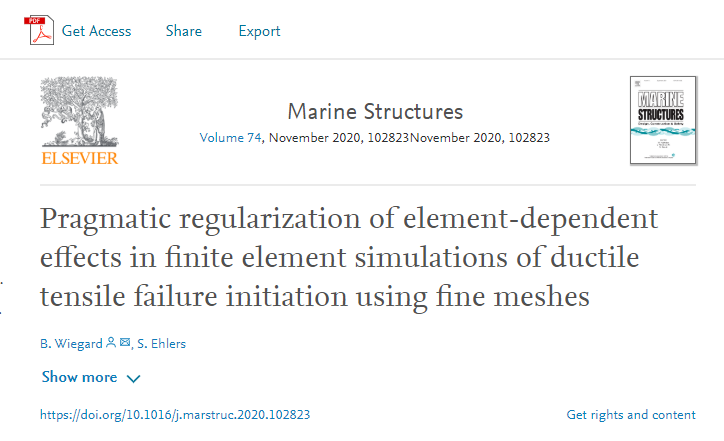
Mar. Struct. (IF 2.708)
Pub Date : 2020-08-24
摘 要
For the evaluation of the structural response in accidental scenarios like ship collisions, the simulation of tensile failure initiation is inevitable. Here, one difficulty is that the process of failure initiation is a very local process, which cannot be simulated in its details at present due to the computing effort which would be required. However, there are various approaches how the failure initiation can be simplified and simulated in finite element models of large thin-walled structures. A short overview of these approaches is given. A pragmatic approach, which is suitable for relatively small elements for the simulation of failure initiation in uniaxial to biaxial stress states, is chosen within this paper for further investigations regarding the applicability for thin-walled steel structures. Exemplary simulations with solid and, in particular, shell elements are used to demonstrate how the effects of element size and other element properties can be considered in the simulation of failure initiation. The focus is also on imperfections that are relevant in simulations with small elements. For this purpose, an indentation experiment is simulated with different imperfections..
链接:
https://www.sciencedirect.com/science/article/abs/pii/S0951833920301179

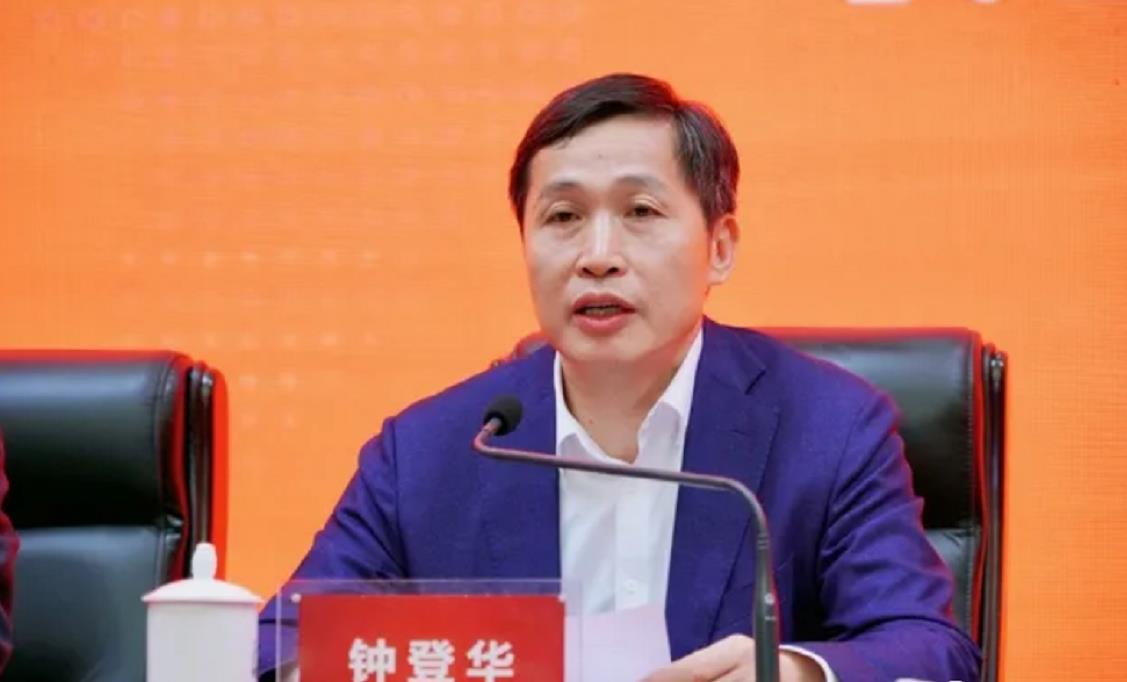




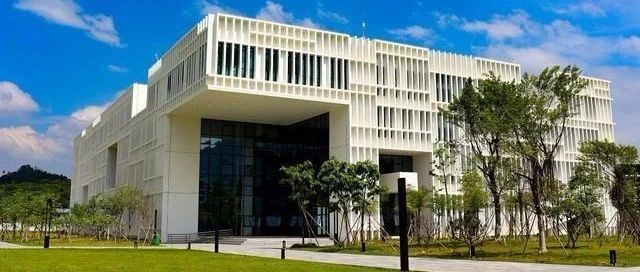









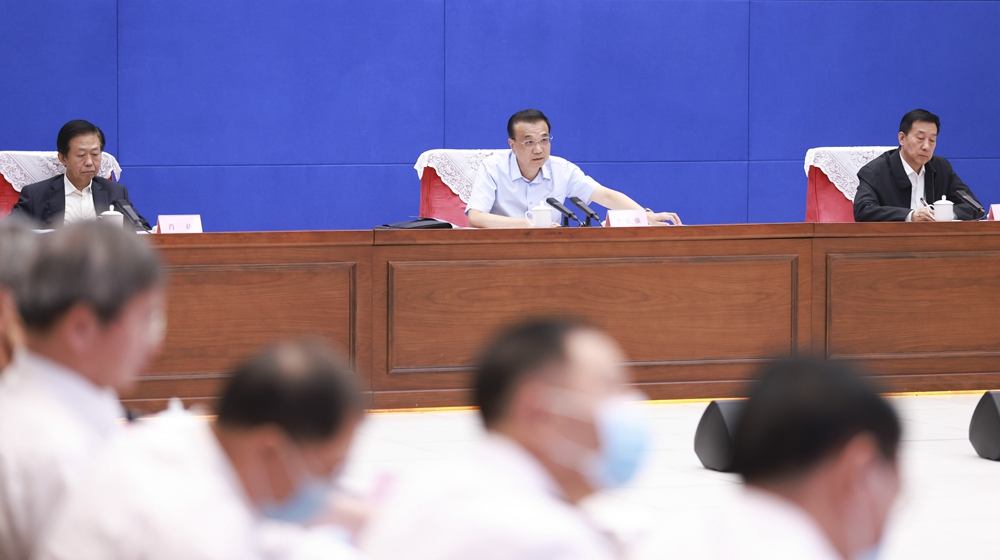
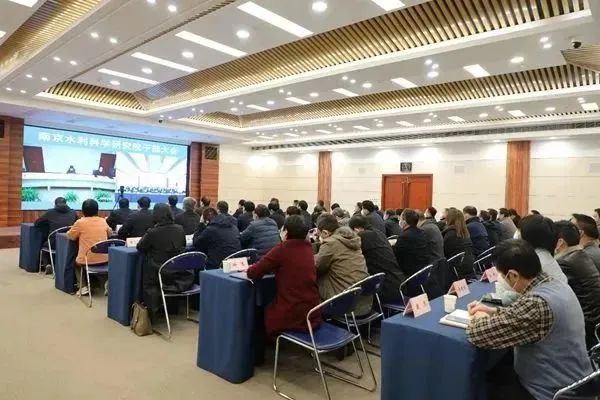







 上一篇
上一篇










